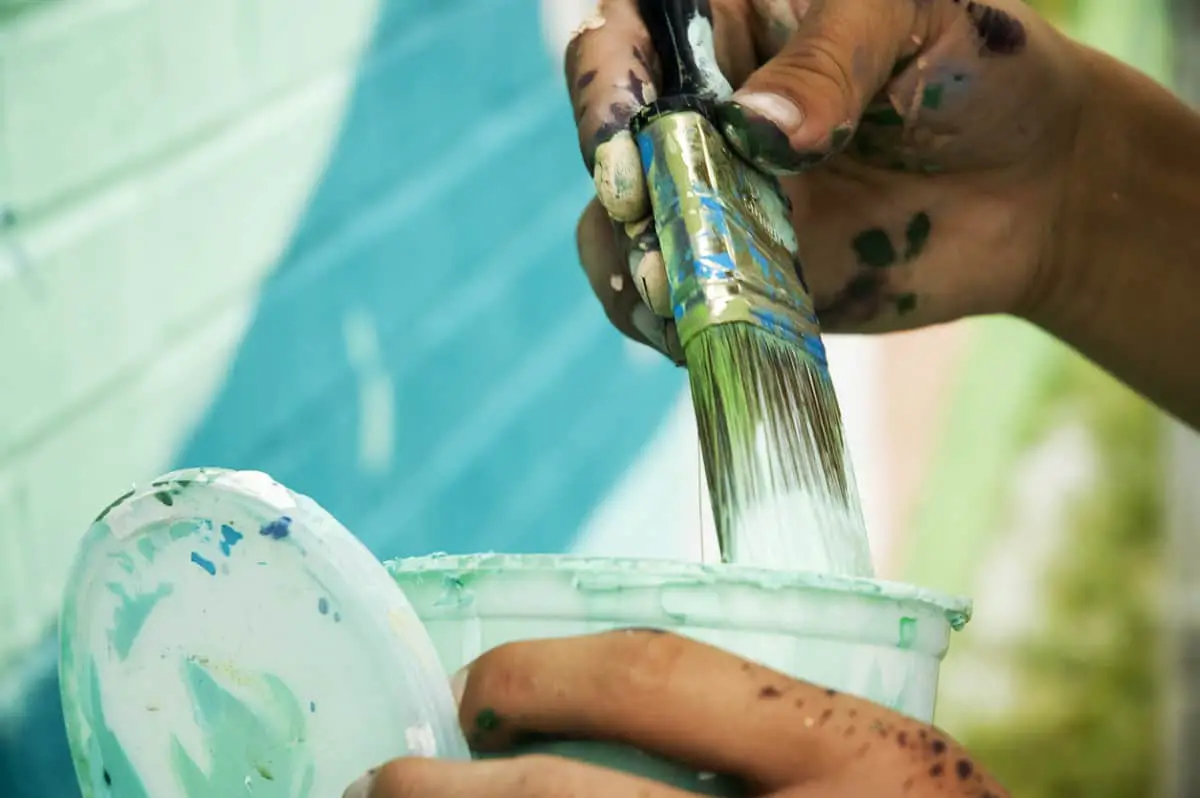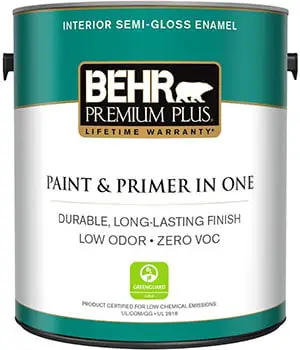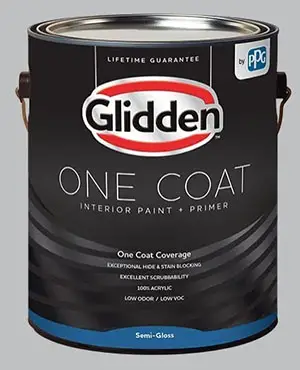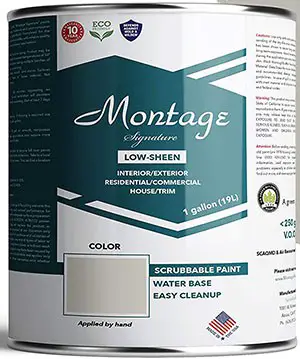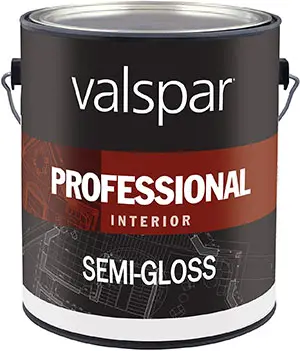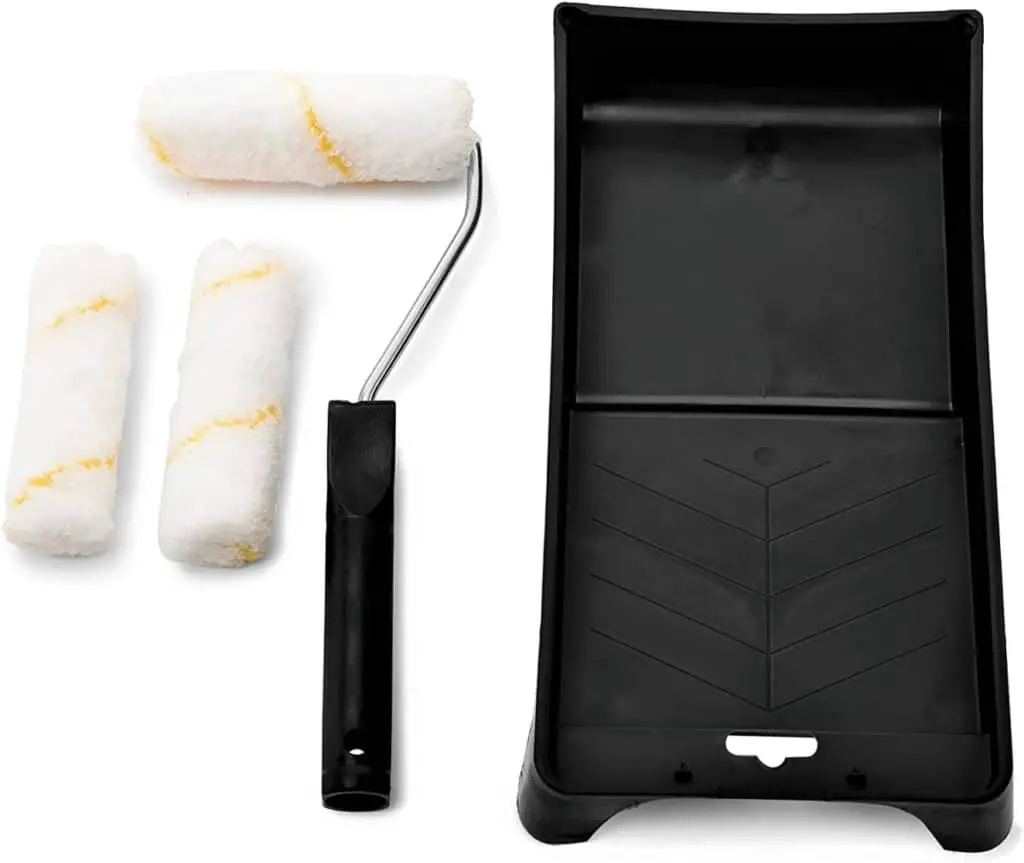One of the best ways to dress up your garage is to paint the walls. Garages are often thought of as a convenience, but they can be so much more. Whether a place to store your cars or keep all of your holiday decorations out of the way, garages tend to get a bad reputation as ugly, unsightly, and cluttered. This, however, does not need to be the case. A few easy and simple things can be done to spruce up your garage space and make it a wonderful organizational area and a lovely room to look at.
There are paints that are great for garage walls and paints that should be avoided. Behr Ultra, Glidden Premium, Montage Signature, and Valspar Signature are the four best paints. Leftover paint, exterior paint, floor paint, and water-based paint are the paints that should be avoided.
Painting the walls of your garage is a pretty simple painting task to accomplish. To achieve outstanding and beautiful results, it is important to prepare your walls before painting them properly. This can be done by cleaning, sanding, and priming them before even bringing out the paint cans and roller brushes. Using proper painting, supplies, and techniques will also be imperative when painting the walls of your garage.
The 4 Best Paints for Your Garage Walls
Behr Ultra
If you’re looking for a strong and hardy paint that will stick to your garage walls and treat them well, the Behr Ultra brand of paints is your go-to.
Behr Ultra paints are typically a type of paint called middle-range, which means they are not an expensive premium paint often used for indoor rooms like living rooms and bedrooms, but they are good quality for your garage walls.
Behr Ultra brand paints are good for garage walls because they are washable and antimicrobial latex-based paints. This means that they are resistant to a build-up of the bacteria that could make you or your family sick and can also be scrubbed clean easily if needed.
They are also stain-resistant, which makes them great for a garage used as a tool shop or vehicle repair space. Additionally, Behr Ultra paints are mold and mildew resistant, offering protection from damaging wall spores that can spread to your car or belongings.
One of the plus sides of purchasing Behr Ultra paint for your garage walls is that it often comes as a paint and primer combination. While this makes the paint stronger and allows it to stick to your walls longer without beginning to chip, it is still a good idea to always use an additional primer underneath the paint for better and longer-lasting effects.
Glidden Premium
Glidden Premium paint is a favorite for people with families and busy schedules. This paint is great for garage walls because it was created to be durable and long-lasting both in garages and in the home.
Not only is this paint strong, but it is also considered one of the most environmentally friendly and family safe paints on the market. This is because it does not contain any dangerous Volatile Organic Compounds and comes in both low odor or odor-free options.
The popularity of Glidden Premium paint comes from its lifetime quality guarantee.
In addition to being family safe, it is also:
- Washable
- Water-resistant
- Mold and mildew resistant
- Claims to be scuff-proof
- Cost-effective
So, you won’t have to worry about saving up to paint the entire garage from wall to wall, and it comes in over one thousand different shades, colors, and tones.
Glidden Premium paint also offers a two in one primer feature. While this adds a perk to the paint’s quality, it does not replace the actual paint primer itself.
Montage Signature
Montage Signature paints are the perfect option for any individual or family who puts a strong emphasis on purchasing environmentally friendly paint.
Montage Signature paint is heavy duty and durable, making it perfect for painting your garage walls. It is known for gliding on thick and luminescent to brighten up your garage space with its Signature Snow White Eggshell color.
Montage Signature paints are made through a process called upcycling. This is like a recycling process for the materials that make up paint.
Montage Signature paints take the ingredients that never go into other paints and combine them to create their perfect paint. Although they do not offer a lifetime guarantee, they do offer: a long 10-year warranty against:
- Scratches
- Scuffs
- Chipping
- Flaking
- Water damage
Valspar Signature
Unlike most garage wall paints made of latex, Valspar Signature paints are based heavily on acrylic ingredients.
Valspar Signature paints are a great choice for the garage because they are tintable, making them more versatile than many other heavy-duty paints.
This paint is considered a high-hiding paint, which means that it is not only a two in one primer paint, but it also goes well over walls that either cannot be scrubbed completely clean, have bits of old paint left on them, or have a few slight damage marks.
While heavy and tintable, Valspar Signature paint tends to dry and set very fast, so painting will need to be done quickly and ideally by multiple hands. This is especially so when painting multiple coats over your garage walls.
The 4 Worst Paint Types for Your Garage Walls
Certain paints were made to be perfect when painted on garage walls.
Other paints, however, do not share similar characteristics.
There are four main types of paint that should be avoided when looking for a paint to spruce up your garage walls. These include:
- Half-empty cans and test samples of leftover paints
- Exterior paints that were created for use on the outside of houses
- Floor paints and glazes
- Water-based paints
Leftover Paint
Leftover paints are never a good idea.
These are one of the types of paints that should be avoided when painting your garage walls. Leftover paints often mean cans of paint that have been:
- Previously opened
- Partially used
- Do not match
Using leftover paint can not only end up damaging your walls due to oxygenation from being left open, but it can also lose its ability to last. It tends to chip more easily than when painting with brand new paints.
The garage is a room that requires strong paints, and leftover paint is often just not strong enough to last.
Exterior Paint
Exterior paints are not to be used for painting your garage walls because they were not created for use indoors. Exterior paints, while very sturdy and strong paints, are often hazardous to the health and should only be used on the outside of homes, rather than in them.
These paints:
- Give off strong fumes and odors
- Are not made from organic materials
- Take a long time to dry
- Have colors that are often very pronounced due to their use outside and exposure to the elements
Exterior paints are also thicker than interior wall paints. Because they were created for textured exterior walls, exterior paint will, therefore, create an odd and lumpy texture on your smooth garage walls.
When looking for garage wall paint with a thick and creamy quality, skip the exterior paint and opt for a two in one primer paint and add multiple coats instead.
Floor Paint
Floor paint is never a good idea to use on walls.
Specialty floor paint is one of the paints that should be avoided when painting your garage walls because it tends to be mixed with glazes, lacquers, and shines that distort the consistency when painted surfaces other than floors.
Floor paint is also not typically considered environmentally healthy or family safe due to the additives we just mentioned.
When painting both the garage walls and the floor of your garage, it is better to purchase strong garage wall paint and use it to paint the floors and the walls. This will create consistency throughout your garage space and help you avoid purchasing expensive and toxic floor paints.
Water-Based Paint
One of the worst paints for your garage walls is a water-based paint.
Water-based paint is a type of paint that is mixed with water rather than made of oils, acrylics, or latex. This means that it can often be easily washable. Water-based paint is not considered:
- Water-resistant
- Mold resistant
- Mildew resistant
It, therefore, causes a problem for garages that are commonly exposed to the elements.
Water-based paint should not be used on your garage walls because, over time, it will begin to fade and drip. It is also not conducive to scrubbing or cleaning, and cannot guarantee any anti-scuff protection.
While water-based paint is typically safe for you and the health of your family, it isn’t worth using on your garage walls because its effects simply will not last.
When is it Time to Paint Your Garage Walls Again?
Painting your garage walls may sound like a daunting task. However, it can be a fun and simple upgrade to anybody’s home. But when is it time for your old garage to get a new coat of paint?
Moisture Build Up
One of the main signs you should consider painting or repainting your garage walls is moisture build-up. If you notice water-based signals such as
- Dripping water from the corners of the room
- The appearance of paint melting down the walls
- Bubbles or bubbling on the walls
- Beads of water on any walls, windows, or doors in the garage
This might mean that you need a paint job on your garage walls, as well as a dehumidifier to protect the new paint.
When garages and other rooms in your home retain excess moisture and have a lot of water build-up, it often means that your paint will not last long.
Noticing the water build-up signs will allow you to choose to address the problem and repair the paint with a new paint job.
Mold or Mildew
Mold and mildew are bad news for any room in any home.
This is especially so when talking about the garage. Your garage is one of the main storage rooms in your home.
Whether you store old family items and memorabilia, your coin collection, important tools, holiday decorations, or cars in your garage, it is important to keep them safe from the damaging mold and mildew that will ruin them.
When mold begins to infest a room of any kind, one of your best lines of defense is to strip the room, including the paint, and start fresh. If you see mold climbing its way into your garage, you first need to address the mold, and then you may want to consider a new and clean coat of paint on your garage walls.
Chipping Paint
Chipping paint is one of the most obvious signs that your last paint job will not last much longer. Whether your chipping paint was painted on the walls 20 years ago or only two years ago, chipping paint has got to go.
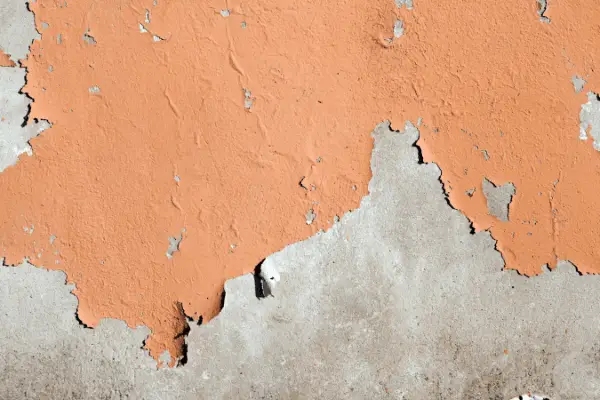
When paint chips, little flakes of paint can end up on your parked cars and in your belongings.
Though most newer paints are no longer made of lead, if accidentally ingested when chipped off, old paints made of lead can be incredibly dangerous for:
- You
- Your family
- Your pets
The best way to keep everyone safe and your garage walls looking beautiful is to opt for a new coat of paint when you start to notice any chipping.
Faded and Dingy Colors
Though faded and dingy colors don’t form a hazard to your family, your cars, or the belongings stored in your garage, they are an eyesore to look at.
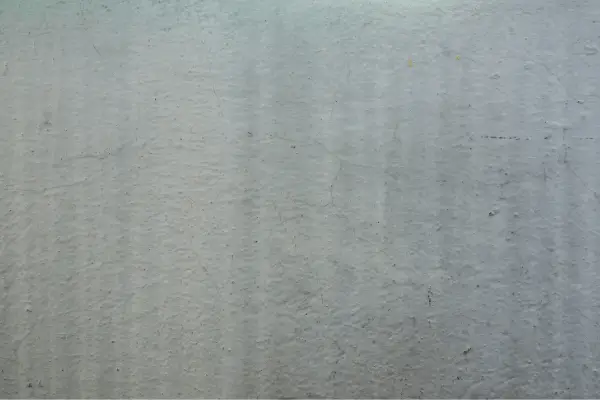
Another sign that you are due for a garage wall paint job is if your original wall colors start to look:
- Faded
- Dingy
- Splotchy
This means that the walls may not have been properly primed or cleaned before having been painted, and you will need to refresh them in order to achieve a nicer and more vibrant aesthetic.
How to Prepare your Garage Walls for Painting
To ensure that your paint will last longer and look amazing on your garage walls, it is important to properly prepare your walls. Though preparing your walls might sound complex, anyone can effectively complete this process. Using simple yet effective wall preparation techniques will help you get the best results possible.
These techniques include:
- Doing an in-depth moisture test
- Scrubbing your garage walls clean of any dirt and residue
- Sanding down all bumps or cracks on your garage walls
- Using a proper primer for your walls
1. Conduct a Moisture Test
Performing a moisture test is incredibly important because any excess moisture in your garage can lead to damaging infestations of mold and mildew, as well as water build-up that threatens to damage both your garage and the belongings stored in it.
Though moisture is easy to recognize when you can see the actual droplets of water on your garage walls, you cannot always see excess moisture with your bare eyes. The following steps will help you complete a successful and in-depth moisture test.
Step 1: Gather a couple of feet of plastic wrap. Clear plastic wrap works best and can be purchased at your local grocery or convenience store.
Step 2: Put the plastic wrap on the floor and use heavy-duty duck tape or electrical tape to seal the sides of the plastic wrap to the corners of the room.
Step 3: Repeat step 2 on all the walls of your garage that are not made of cement.
Step 4: Leave the tape and plastic wrap for a few days without disturbing them.
Step 5: Check to see if you notice water droplets through the clear plastic wrap, then remove the plastic wrap and check to see if you can feel water underneath it. If so, you might have a moisture build-up problem in your garage.
Step 6: If you find that you have a moisture problem, you will need to address it. To care for the problem, set up large fans, open all doors to the garage to air, and dry the moisture. If the moisture problem does not resolve by air drying, you will need to call a professional.
2. Clean your Garage Walls
Having clean walls is imperative when getting them ready for primer and a new coat of paint, doubly so in your garage where the walls are more exposed to the elements throughout the year.
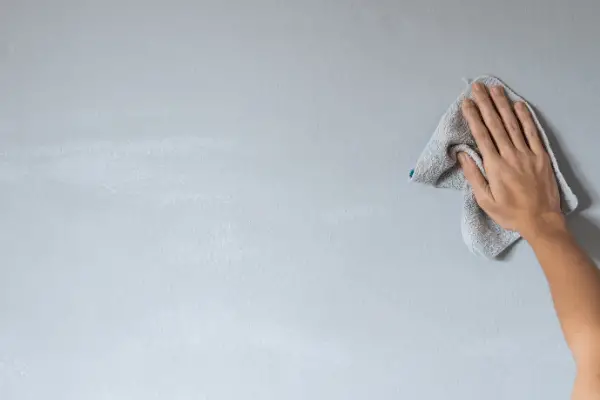
You can clean your garage walls by:
- Stripping any existing paint
- Getting a rough sponge and dish soap to scrub off the remaining dirt
- Using car shop towels or floor rags to wipe down the remaining water
- Setting up fans to let the walls dry
Once your garage walls are clean, they will not only hold the paint better but be safer for the health of your family and the safety of your stored belongings.
3. Sand your Garage Walls
Sanding the walls of your garage is a great and easy way to make sure that both your primer and paint go on smoothly without any extra lumps, bumps, or bubbles.
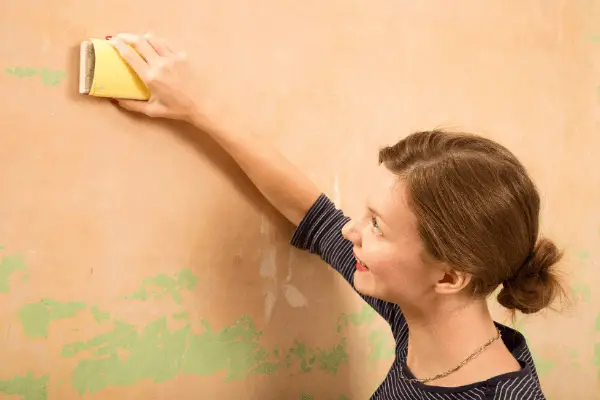
To sand your walls, make sure to wash them first, then gather heavy-duty sandpaper from your local hardware store.
Once you have your sandpaper or sanding tools, there may be imperfections on your garage walls that need to be smoothed down.
Look for:
- Any uneven spots
- Chipping
- Cracks
- Bumps
After you are finished sanding, wipe the walls with a slightly damp cloth to remove any bits of residue.
4. Properly Priming your Walls
Picking the right primer for your garage walls is almost as important as picking the right paint. But what does primer do?
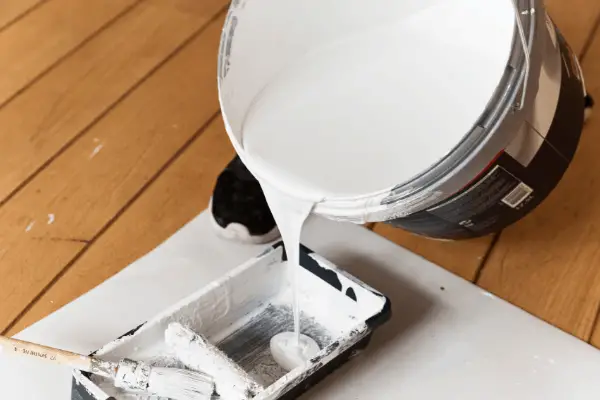
Primer paint is actually just a coast of paint that goes underneath your paint color. Primer paint allows for your paint to adhere to the walls and sticks strongly. It also adds a little bit of insulation to the space by sealing your walls to the paint’s topcoats.
The primer’s main importance is to protect your walls from water damage and stop your paint from chipping.
Rust-Oleum Primer (link to Amazon) is one of the best garage primers on the market and can offer your garage walls premium protection.
Choosing the Best Color for Your Garage Walls
Choosing a color to paint your garage walls is one of the most difficult and exciting tasks when it comes to painting your garage.
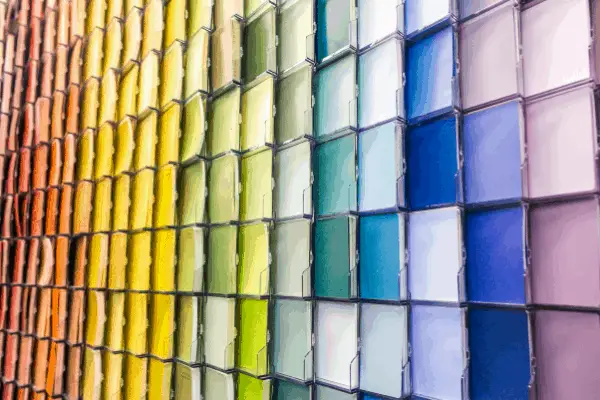
As we mentioned at the start of the article, garages are often known as utilitarian spaces that lack charisma and glamor. This is because they are used as storage, whether to park your family cars or to house items that otherwise would have nowhere to go.
Sometimes garages are used as tool shops or car repair areas. This can subject them to stains and dingy colors.
While the garage is a place of practicality and storage, that does not necessarily mean that your garage wall paint color needs to be boring or sad.
You can bring new life to your once uninviting garage walls with colors such as:
- Eggshell
- Light blue
- Navy
- Olive green
- Aquatic gray
- Beige
When to Choose a Darker Color
The best time to pick a dark color for your garage walls is if there are windows that let some light into your garage, or if your garage is used to store light-sensitive items.
Popular to contrary belief, various colors can allow for a deep and dark hue without getting too dreary. Dark colors don’t necessarily need to include black and charcoal.
Think of colors like:
- Navy
- Aquatic gray
- Olive green
How to Know When a Light Color is Best
You should choose a lighter color for your garage walls when you spend a lot of time in your garage.
This could mean using your garage as:
- A workstation
- A tool shed
- A workshop for crafts and projects
If you often go in and out of your garage, park your cars in your garage, or enter and exit the home through this room, a light color will be best for you.
If you want a calm, yet sleek and simple look to your garage, that allows it to be an inviting and joyful place rather than an unwelcoming room used only for storing items, choose colors such as:
- Eggshell
- Beige
- Light blue
The Right Supplies for Painting Your Garage Walls
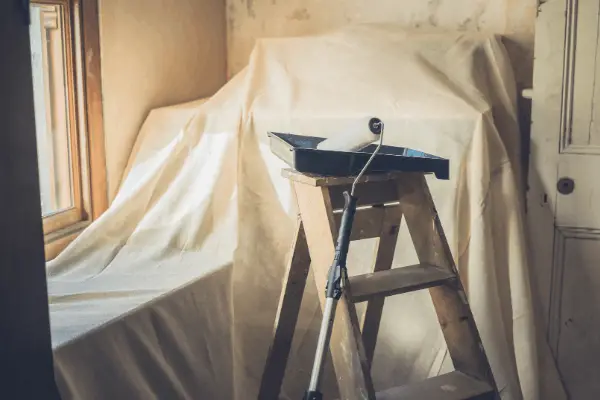
Once you have found the perfect paint for your garage walls, it is time to get to work. Before you prepare, prime, and paint your walls, make sure to have the right items on hand for a safe, clean, and easy painting process.
This will make things more enjoyable for both you and your family.
A Tarp for Protection and Easy Clean Up
It is always a great idea to cover your belongings in protective layers of tarps and plastic before painting. This will keep them safe and dry during the entire:
- Prepping
- Priming
- Painting process
Laying down a tarp below the wall that you are painting to cover the floors will also make for easy cleanup and help avoid any stains from drips or spills while painting.
Once you are finished with one wall, simply pick up the floor tarp, wipe it down or hose it off, and place it under the next garage wall that you plan to paint.
This heavyweight canvas drop cloth from Amazon is what I recommend.
Roller Brushes, Not Handle Brushes
The best way to apply paint to large walls such as the walls found in your garage is to use roller brushes.
Roller brushes can be inserted onto either a long or short handle and are round, tube-shaped brushes. These brushes make painting fast and easy when covering a large span of the surface.
Handle brushes, on the other hand, are good for painting detailed surfaces, corners, and around light sockets. They should be used only in small areas where the roller brushes cannot reach.
This paint tray and roller brush kit from Amazon is what I recommend.
A Sturdy Ladder
Garage ceilings are often high enough to accommodate expansive storage and large vehicles. This means that the walls in your garage will be equally as high.
When painting high up, it is important to have a safe and sturdy ladder. This will ensure that you can properly reach all corners of the wall and not have to double back later to fill in any gaps.
When using a tall ladder, make sure always to have a second person there to hold the ladder steady and watch for your safety.
Enjoying your Beautifully Painted Garage
Painting your garage walls can transform your entire garage space from messy, cluttered, and uninviting, to bright, airy, and welcoming.
Finding the best paint for your garage walls will make the process fun and easy, as well as ensure that your garage walls will continue to look their best for years to come.
Whether you decide on dark and industrial colors or light and airy hues, knowing which paints are best for your garage walls and which paint to avoid is imperative in guaranteeing your painting success.

